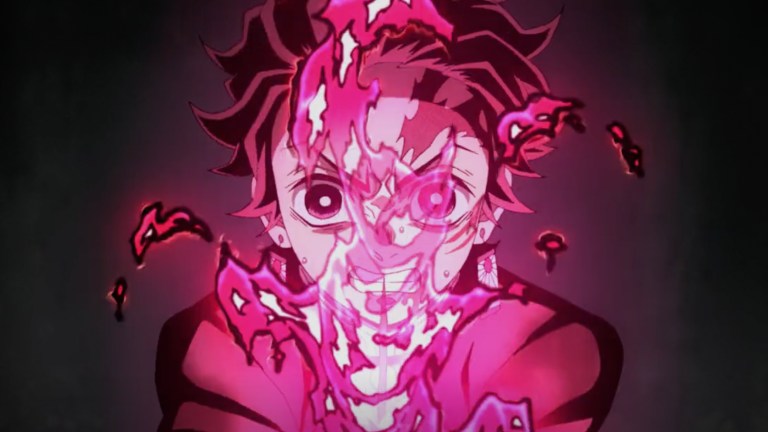Demon Slayer Season 3 Episode 5 Review: Bright Red Sword
Tanjiro and company’s battle against Upper Rank Gyokko and Hantengu intensifies, but a major breakthrough may come at the ultimate cost.

This Demon Slayer review contains spoilers.
Demon Slayer Season 3 Episode 5
“You have no eye for beauty, you damn ape!”
Teamwork is a vital tenet that’s helped the Demon Slayer Corps survive for as long as it has. Tanjiro has never discouraged another warrior’s help on the battlefield, but the battle against Upper Rank Hantengu has been unique in the sense that he’s literally divided himself into four separate fighters. Additionally, Gyokko’s grotesque fish warriors terrorize an entire village in tandem. “Bright Red Sword” marks some of Demon Slayer’s teamwork at its very best in a scenario where everyone contributes to combat in their own way, which unfortunately in this case may cost one member of the group their humanity in the process.
The previous Demon Slayer installment doesn’t struggle to establish the dangers of Hantengu. These threats are still very much a concern in “Bright Red Sword,” but this episode also takes greater strides to showcase how dangerous Gyokko can be when he really sets his mind to mayhem. Mitsuri Kanroji, Demon Slayer’s Love Hashira, adeptly slices through hordes of fish monster minions. There’s beautiful battle choreography that’s a cathartic release of carnage that thrives during the episode’s first act where the heroes call the shots before Demon Slayer settles into more uncertain territory as Hantengu’s talents escalate.
Ufotable has done particularly gorgeous work this season when it comes to both Demon Slayer’s exaggerated action sequences and more muted moments. “Bright Red Sword” includes some stunning scenes where characters disintegrate upon destruction as Mitsuri slices and dices through dozens of demons, en masse, as well as toppling singular demon behemoths. Mitsuri’s sword whip is also a nice change of pace that adds greater acrobatic qualities to her strikes that stand out from Tanjiro and the rest of the Demon Slayers.
Additionally, “Bright Red Sword” features equally impressive spectacles where Nezuko dodges electricity bursts from Hantengu’s disciples. Red and blue flashing bolts punctuate the fight like it’s some retro 3D glasses exercise. This contrasts against the green bursts of Hantengu’s wind bursts, all of which contribute towards a really inventive, smart, and creative color palette that represents the different villains and stages of this fight. It’s a really inspired idea that helps this battle stand out even more over the series’ other major demon showdowns.
Tokito versus Gyokko delights when it comes to action as a three-on-one altercation occurs. What stands out even more than the combat is Gyokko’s twisted passion over his horrific creations that he refers to as his “artwork.” It’s a particularly twisted look into the demon’s psychology. Gyokko’s “Death Throes of the Smith” turns five members of the Swordsmith Village into Hannibal level corpse art that’s genuinely disturbing. “Bright Red Sword” leans into the pain of this display to better torture the survivors and dig the blade deeper.
Gyokko even recreates these fallen fighters’ death rattles to echo some eternal macabre cacophony that these demons reappropriate into art. It’s another effective glimpse into the disturbing nature of these creatures. It’s one thing to see enemies who have intimidating strength and terrifying designs, but it’s this genuinely evil behavior that’s made these Upper Rank Demons stand out and properly emphasizes their heightened levels of depravity. This is all compounded by Gyokko’s grim trigger where Tokito and others fail to properly respect and admire his nightmarish artwork rather than an insolence that has anything to do with their strength or values. It establishes just how dedicated Gyokko is to his cruel craft.
Another macabre turn from this demon involves the unexpected Mega Man-eaque turn that Gyokko adopts once his hand morphs into a vase-cannon that fires weaponized goldfish. It’s particularly inventive and shows just how wild and silly Demon Slayer can get with its tense action sequences and the depth that these exciting moments can gain where they’re not just purely stressful exchanges of strength. These goldfish may look borderline cute, but the nail-like spikes that they spit out are brutally fatal and induce painful cringes.
Tokito gets put through the wringer in this episode by Gyokko and some of his worst treatment involves when he’s suffocated by the Upper Rank Demon’s upgraded water-based Blood Art that keeps the slayer suspended in liquid and progressively robs him of oxygen. It’s a barrier that proves to be too powerful for Tokito’s blade to simply pierce. It further speaks towards how much Gyokko can accomplish with his demonic advantages.
“Bright Red Sword” also concludes with an inspirational display of power courtesy of the Kamado siblings. Nezuko taps into new Demon Blood Art pyrotechnics that might become the key to Hantengu’s defeat. It’s so much fun to envision a version of Demon Slayer in one or two seasons down the road where Tanjiro and Nezuko can fight as a proper sibling team without any caveats. Nezuko’s Raging Sword transforms into the devastating Sun Halo Dragon maneuver as Tanjiro executes all of Hantengu’s clones at once in the season’s most visually stunning sequence. It’s becoming increasingly difficult for Demon Slayer to find ways to top itself when it comes to its animation, but the colors and fires that pop and explode in combat really get the most out of ufotable and show what this company can do.
For a brief, glorious moment it looks like the heroes may have won this battle through Tanjiro’s treacherous simultaneous strike. However Genya, in a terrifying turn of events, seems to have been transformed into a demon or become Hantengu’s possessed vessel through some vile takeover. Either way, it’s a morally complex wrinkle to consider for the upcoming final stage of this grandiose fight.
A hero who finds themselves under villainous possession has become well-trodden territory for shonen series. What makes it feel exciting here with Genya is that Demon Slayer has reached a point where it feels like Genya’s fate is final and Tanjiro will be forced to kill his new friend rather than the series turning to some convenient cure. The fact that Demon Slayer has even reached a point where it inspires this kind of thought in its audience is just encouraging in itself for where its tone and storytelling has reached.
“Bright Red Sword” also provides another tantalizing glimpse into Tanjiro’s inherited memories and the cryptic nature of what they mean. At this point they don’t feel dissimilar from Midoriya’s vestige sessions in My Hero Academia and it’s failed to establish its own personality here. If nothing else, it’s satisfying to see a deeper mystery develop for the season’s second half. It definitely feels like Tanjiro’s brief visions of the past will play a crucial role in his victory over this season’s literal and metaphorical demons.
“Bright Red Sword” continues this season’s major battle in entertaining ways, but it’s now reached a point where pacing is beginning to be a problem. It’s unclear how long the Gyokko and Hantengu assault will last and that it might even sustain the entire season now that Demon Slayer is approaching its half-way mark.
This season also deserves a lot of respect for the ongoing complete absence of regular Demon Slayer delights, Zenitsu and Inosuke. Tokito and Kanroji slide in as Tanjiro and Nezuko’s supporting players, who are great and quickly build their own shorthand, but it’s not the same. Zenitsu and Inosuke are missed to some extent this season and it’s interesting to think how they’d perform against Gyokko and Hantengu. However, this fresh blood really makes a big difference this season and helps give these fights a unique flavor.
“Bright Red Sword” is another strong addition to Demon Slayer’s Swordsmith Village season that’s heavy in action, emotion, and unpredictable events that highlight these warriors and monsters at their very best. It builds suspense and increases the stakes of this prolonged battle with complications that feel natural to the unique chaos at hand. That being said, if some of these decapitations don’t stick then this season is going to face trouble as it runs out of tricks.
